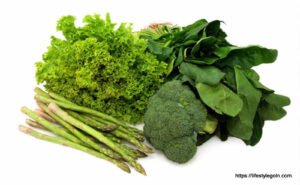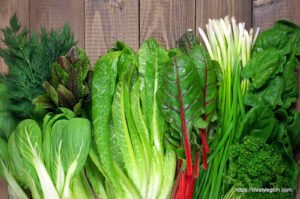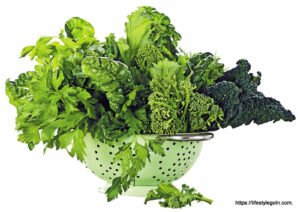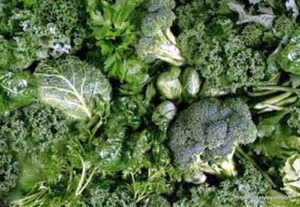Green leafy vegetables are an essential component of a balanced diet and have been revered for their nutritional value for centuries. Packed with vitamins, minerals, fiber, and phytonutrients, these leafy wonders play a crucial role in promoting overall health and preventing various chronic diseases. In this essay, we will explore the health benefits, nutritional profile, and culinary versatility of green leafy vegetables, as well as their impact on various aspects of human health.
Green Leafy Vegetables

Section 1: Nutritional Composition of Green Leafy Vegetables
Green leafy vegetables boast an impressive nutritional profile that sets them apart as a powerhouse of health-promoting substances. Rich in vitamins such as A, C, K, and folate, they also provide essential minerals like iron, calcium, magnesium, and potassium. Additionally, they are a significant source of dietary fiber, which aids in digestion and supports gut health.
1.1 Vitamins and Minerals:
Green leafy vegetables, like spinach, kale, and collard greens, are excellent sources of vitamin K, vital for blood clotting and bone health. They also contain abundant vitamin A, which contributes to vision, skin health, and immune function. Vitamin C, found in greens like broccoli and Brussels sprouts, acts as a powerful antioxidant, protecting cells from oxidative stress and enhancing immune responses.
1.2 Phytonutrients:
Green leafy vegetables are rich in phytonutrients such as carotenoids, flavonoids, and chlorophyll. These compounds have been associated with antioxidant, anti-inflammatory, and anticancer properties, making leafy greens an essential part of a disease-preventive diet.

Section 2: Health Benefits of Green Leafy Vegetables
2.1 Cardiovascular Health:
The consumption of green leafy vegetables has been linked to improved cardiovascular health. Their high potassium content helps regulate blood pressure, reducing the risk of hypertension and stroke. Moreover, the presence of nitrate compounds in leafy greens enhances blood flow and supports healthy endothelial function, benefiting heart health.
2.2 Cancer Prevention:
Studies suggest that a diet rich in green leafy vegetables may reduce the risk of certain cancers, including lung, breast, and colorectal cancer. The phytochemicals present in these greens have shown anticancer effects by neutralizing harmful free radicals and inhibiting tumor growth.
2.3 Bone Health:
The abundance of vitamin K in green leafy vegetables is crucial for maintaining bone density and preventing osteoporosis. Adequate intake of these greens, along with calcium-rich foods, supports skeletal health and reduces the risk of fractures.
2.4 Vision and Eye Health:
The high levels of carotenoids, particularly lutein and zeaxanthin, found in green leafy vegetables contribute to eye health. These compounds protect the eyes from harmful UV rays and may reduce the risk of age-related macular degeneration and cataracts.
2.5 Weight Management and Digestive Health:
The fiber content in green leafy vegetables aids in weight management by promoting a feeling of fullness and curbing unnecessary food intake. Additionally, dietary fiber supports digestive health by preventing constipation and promoting a healthy gut microbiome.

Section 3: Culinary Versatility of Green Leafy Vegetables
One of the greatest strengths of green leafy vegetables is their culinary versatility. They can be incorporated into a wide range of dishes, adding flavor, texture, and nutritional value.
3.1 Salads:
Green leafy vegetables form the backbone of countless salad recipes. From simple mixed greens to elaborate Caesar or Waldorf salads, they provide a refreshing and nutritious base for various toppings and dressings.
3.2 Smoothies:
Leafy greens like spinach and kale blend seamlessly into smoothies, providing a nutrient-rich boost without altering the taste significantly. These greens enhance the nutritional content of the smoothie and offer an easy way to consume more vegetables.
3.3 Sauteed and Stir-Fried:
Leafy greens are often sautéed or stir-fried, complementing the flavors of other vegetables and proteins. Dishes like garlic sautéed spinach or Asian stir-fried bok choy showcase the versatility and deliciousness of these vegetables.
3.4 Soups and Stews:
Leafy greens, such as collard greens or Swiss chard, are common additions to soups and stews, imparting a rich flavor and nutritional density to the dish.

Section 4: Incorporating Green Leafy Vegetables into the Diet
While the benefits of green leafy vegetables are well-established, many people struggle to incorporate them into their daily diets. Here are some practical tips to increase the consumption of these nutritional powerhouses:
4.1 Start Slowly:
For those new to green leafy vegetables, it’s best to start with milder-tasting greens, such as lettuce or baby spinach, and gradually expand to more robust flavors like kale or arugula.
4.2 Blend in Smoothies:
Adding a handful of spinach or kale to your favorite fruit smoothie is a simple and delicious way to consume leafy greens, especially for those who find the taste off-putting.
4.3 Mix into Sauces:
Finely chop or puree leafy greens and mix them into pasta sauces, curry gravies, or even homemade pesto to amp up the nutritional content of your meals.
4.4 Experiment with Recipes:
Explore various recipes that incorporate green leafy vegetables in innovative ways. Try recipes from different cultures to discover new flavors and textures.

Section 5: Growing Green Leafy Vegetables at Home
Growing green leafy vegetables at home can be a rewarding and sustainable way to ensure a fresh supply of nutrient-rich greens. Whether you have a spacious garden or limited balcony space, there are various methods to grow these vegetables:
5.1 Container Gardening:
Even with limited space, you can grow green leafy vegetables in containers. Choose shallow pots or containers with good drainage, and plant varieties like lettuce, spinach, or Swiss chard. Place them in a sunny spot and water regularly to enjoy a homegrown harvest.
5.2 Vertical Gardening:
Vertical gardening is an excellent option for those with small spaces. Create a vertical garden using wall-mounted planters or repurposed materials, and grow greens like kale or collard greens. Vertical gardens not only save space but also add a touch of green to urban settings.
5.3 Raised Beds:
If you have a backyard or a larger area, consider creating raised beds for growing green leafy vegetables. Raised beds provide better soil drainage, and you can control the quality of the soil, making it easier to grow a variety of greens.
5.4 Hydroponics and Indoor Gardening:
For year-round greens, consider hydroponics or indoor gardening systems. Hydroponic setups use nutrient-rich water instead of soil, allowing you to grow leafy vegetables indoors, regardless of the season.

Section 6: Common Green Leafy Vegetables and Their Benefits
6.1 Spinach:
Spinach is a nutritional powerhouse, rich in vitamins A, C, and K, as well as iron and folate. It supports bone health, boosts the immune system, and aids in maintaining healthy skin and vision.
6.2 Kale:
Kale is loaded with antioxidants, including vitamins A, C, and K, as well as calcium and potassium. It supports cardiovascular health, reduces inflammation, and promotes detoxification.
6.3 Swiss Chard:
Swiss chard is an excellent source of vitamins K, A, and C, and minerals like magnesium and potassium. It supports bone health, aids in digestion, and may help regulate blood sugar levels.
6.4 Collard Greens:
Collard greens are rich in calcium, vitamin K, and antioxidants. They promote heart health, aid in digestion, and support the body’s natural detoxification processes.
6.5 Arugula:
Arugula contains high levels of vitamin K and antioxidants. It supports bone health, helps reduce inflammation, and adds a peppery flavor to dishes.

Section 7: Potential Risks and Precautions
While green leafy vegetables are generally safe and beneficial for most people, there are a few considerations to keep in mind:
7.1 Oxalates:
Some leafy greens, like spinach and Swiss chard, contain oxalates, which may interfere with the absorption of certain minerals like calcium and iron. Individuals with kidney stones or specific health conditions should consume these greens in moderation.
7.2 Pesticides:
Conventionally grown leafy vegetables may contain pesticide residues. To minimize exposure, choose organic options whenever possible, or wash thoroughly before consumption.
7.3 Allergies:
Individuals with allergies to certain plant families, such as ragweed or Asteraceae, may also experience cross-reactivity with greens like lettuce or spinach. It is essential to be mindful of any adverse reactions.

Section 8: Green Leafy Vegetables and Sustainable Agriculture
In addition to their nutritional and health benefits, green leafy vegetables play a vital role in sustainable agriculture and environmental preservation.
8.1 Reduced Environmental Impact:
Compared to other agricultural products, green leafy vegetables often have a lower environmental footprint. They generally require less water and space to grow, making them more sustainable choices for regions facing water scarcity and land constraints.
8.2 Biodiversity and Crop Rotation:
Growing a variety of green leafy vegetables supports biodiversity in agriculture. Crop rotation, a common practice in organic farming, involves planting different crops in a sequence to maintain soil health, reduce pests, and enhance nutrient availability. Including leafy greens in crop rotation helps break pest and disease cycles and fosters sustainable agriculture.
8.3 Composting and Soil Health:
Green leafy vegetables can be composted, contributing to nutrient-rich organic matter for soil improvement. Compost enhances soil structure, water retention, and nutrient content, reducing the need for synthetic fertilizers and promoting sustainable farming practices.

Section 9: Traditional and Cultural Significance
Green leafy vegetables have deep-rooted traditional and cultural significance in many societies. They are often celebrated in local cuisines and culinary traditions, passed down from generation to generation.
9.1 Asian Greens:
In Asian cuisines, leafy greens like bok choy, water spinach, and Chinese broccoli are staples in many dishes. These vegetables are stir-fried, added to soups, or used in dumplings and spring rolls, reflecting the rich culinary heritage of the region.
9.2 Mediterranean Greens:
Mediterranean cuisine also celebrates leafy vegetables, with dishes like Greek spanakopita (spinach pie) and Italian dishes featuring Swiss chard and arugula. These greens contribute to the distinct flavors and nutritional richness of Mediterranean meals.
9.3 Indigenous and Native Uses:
In indigenous and native cultures, green leafy vegetables have been utilized for their medicinal properties and dietary value for centuries. They play a significant role in traditional healing practices and are valued as essential food sources in diverse cultural contexts.

Section 10: Encouraging Leafy Green Consumption
To promote the consumption of green leafy vegetables and improve public health, various initiatives and educational programs can be implemented:
10.1 School and Community Gardens:
Introducing school and community gardens can engage children and adults in the cultivation and consumption of green leafy vegetables. These initiatives provide valuable hands-on learning experiences and foster a sense of responsibility towards the environment.
10.2 Nutrition Education Programs:
Nutrition education programs, both in schools and community centers, can emphasize the importance of leafy greens in a balanced diet. Teaching cooking skills and creative recipes can encourage individuals to explore and appreciate the culinary versatility of these vegetables.
10.3 Public Policy and Food Accessibility:
Government policies that prioritize sustainable agriculture and food accessibility can contribute to the availability of fresh and affordable green leafy vegetables in local markets. Incentives for organic farming and support for farmers’ markets can make these nutritious options more accessible to a wider population.

Green leafy vegetables are more than just a collection of nutrients; they are a celebration of life, culture, and sustainability. Their nutritional density, culinary versatility, and positive impact on human health make them a treasured part of diets across the globe.
From supporting cardiovascular health to promoting bone density, green leafy vegetables offer an array of benefits. Incorporating them into our daily meals, experimenting with diverse recipes, and even growing them at home are all steps towards embracing a healthier and more sustainable lifestyle.
Furthermore, through sustainable agriculture practices, green leafy vegetables contribute to environmental preservation, making them an essential component of a greener, more resilient future. By educating individuals about the significance of these vegetables and promoting their consumption through various initiatives, we can empower people to make informed dietary choices that benefit both themselves and the planet.
In essence, green leafy vegetables symbolize the harmonious relationship between human health, cultural heritage, and ecological well-being. As we continue to explore their potential, let us recognize the true worth of these nutritional gems and savor the nourishment they bring to our lives.
See more:

